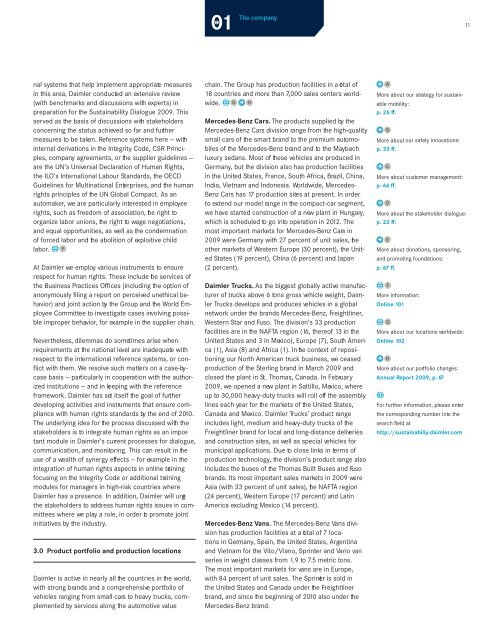Daimler Sustainability Report 2010 - Daimler Sustainability Report ...
Daimler Sustainability Report 2010 - Daimler Sustainability Report ...
Daimler Sustainability Report 2010 - Daimler Sustainability Report ...
Create successful ePaper yourself
Turn your PDF publications into a flip-book with our unique Google optimized e-Paper software.
nal systems that help implement appropriate measures<br />
in this area, <strong>Daimler</strong> conducted an extensive review<br />
(with benchmarks and discussions with experts) in<br />
preparation for the <strong>Sustainability</strong> Dialogue 2009. This<br />
served as the basis of discussions with stakeholders<br />
concerning the status achieved so far and further<br />
measures to be taken. Reference systems here — with<br />
internal derivations in the Integrity Code, CSR Principles,<br />
company agreements, or the supplier guidelines —<br />
are the UN’s Universal Declaration of Human Rights,<br />
the ILO’s International Labour Standards, the OECD<br />
Guidelines for Multinational Enterprises, and the human<br />
rights principles of the UN Global Compact. As an<br />
automaker, we are particularly interested in employee<br />
rights, such as freedom of association, the right to<br />
organize labor unions, the right to wage negotiations,<br />
and equal opportunities, as well as the condemnation<br />
of forced labor and the abolition of exploitive child<br />
labor. q F<br />
At <strong>Daimler</strong> we employ various instruments to ensure<br />
respect for human rights. These include the services of<br />
the Business Practices Offices (including the option of<br />
anonymously filing a report on perceived unethical behavior)<br />
and joint action by the Group and the World Employee<br />
Committee to investigate cases involving possible<br />
improper behavior, for example in the supplier chain.<br />
Nevertheless, dilemmas do sometimes arise when<br />
requirements at the national level are inadequate with<br />
respect to the international reference systems, or conflict<br />
with them. We resolve such matters on a case-bycase<br />
basis — particularly in cooperation with the authorized<br />
institutions — and in keeping with the reference<br />
framework. <strong>Daimler</strong> has set itself the goal of further<br />
developing activities and instruments that ensure compliance<br />
with human rights standards by the end of <strong>2010</strong>.<br />
The underlying idea for the process discussed with the<br />
stakeholders is to integrate human rights as an important<br />
module in <strong>Daimler</strong>’s current processes for dialogue,<br />
communication, and monitoring. This can result in the<br />
use of a wealth of synergy effects — for example in the<br />
integration of human rights aspects in online training<br />
focusing on the Integrity Code or additional training<br />
modules for managers in high-risk countries where<br />
<strong>Daimler</strong> has a presence. In addition, <strong>Daimler</strong> will urge<br />
the stakeholders to address human rights issues in committees<br />
where we play a role, in order to promote joint<br />
initiatives by the industry.<br />
3.0 Product portfolio and production locations<br />
<strong>Daimler</strong> is active in nearly all the countries in the world,<br />
with strong brands and a comprehensive portfolio of<br />
vehicles ranging from small cars to heavy trucks, complemented<br />
by services along the automotive value<br />
The company<br />
chain. The Group has production facilities in a total of<br />
18 countries and more than 7,000 sales centers worldwide.<br />
q G D H<br />
Mercedes-Benz Cars. The products supplied by the<br />
Mercedes-Benz Cars division range from the high-quality<br />
small cars of the smart brand to the premium automobiles<br />
of the Mercedes-Benz brand and to the Maybach<br />
luxury sedans. Most of these vehicles are produced in<br />
Germany, but the division also has production facilities<br />
in the United States, France, South Africa, Brazil, China,<br />
India, Vietnam and Indonesia. Worldwide, Mercedes-<br />
Benz Cars has 17 production sites at present. In order<br />
to extend our model range in the compact-car segment,<br />
we have started construction of a new plant in Hungary,<br />
which is scheduled to go into operation in 2012. The<br />
most important markets for Mercedes-Benz Cars in<br />
2009 were Germany with 27 percent of unit sales, the<br />
other markets of Western Europe (30 percent), the United<br />
States (19 percent), China (6 percent) and Japan<br />
(2 percent).<br />
<strong>Daimler</strong> Trucks. As the biggest globally active manufacturer<br />
of trucks above 6 tons gross vehicle weight, <strong>Daimler</strong><br />
Trucks develops and produces vehicles in a global<br />
network under the brands Mercedes-Benz, Freightliner,<br />
Western Star and Fuso. The division’s 33 production<br />
facilities are in the NAFTA region (16, thereof 13 in the<br />
United States and 3 in Mexico), Europe (7), South America<br />
(1), Asia (8) and Africa (1). In the context of repositioning<br />
our North American truck business, we ceased<br />
production of the Sterling brand in March 2009 and<br />
closed the plant in St. Thomas, Canada. In February<br />
2009, we opened a new plant in Saltillo, Mexico, where<br />
up to 30,000 heavy-duty trucks will roll off the assembly<br />
lines each year for the markets of the United States,<br />
Canada and Mexico. <strong>Daimler</strong> Trucks’ product range<br />
includes light, medium and heavy-duty trucks of the<br />
Freightliner brand for local and long-distance deliveries<br />
and construction sites, as well as special vehicles for<br />
municipal applications. Due to close links in terms of<br />
production technology, the division’s product range also<br />
includes the buses of the Thomas Built Buses and Fuso<br />
brands. Its most important sales markets in 2009 were<br />
Asia (with 33 percent of unit sales), the NAFTA region<br />
(24 percent), Western Europe (17 percent) and Latin<br />
America excluding Mexico (14 percent).<br />
Mercedes-Benz Vans. The Mercedes-Benz Vans division<br />
has production facilities at a total of 7 locations<br />
in Germany, Spain, the United States, Argentina<br />
and Vietnam for the Vito/Viano, Sprinter and Vario van<br />
series in weight classes from 1.9 to 7.5 metric tons.<br />
The most important markets for vans are in Europe,<br />
with 84 percent of unit sales. The Sprinter is sold in<br />
the United States and Canada under the Freightliner<br />
brand, and since the beginning of <strong>2010</strong> also under the<br />
Mercedes-Benz brand.<br />
D A<br />
More about our strategy for sustainable<br />
mobility:<br />
p. 26 ff.<br />
D B<br />
More about our safety innovations:<br />
p. 33 ff.<br />
D C<br />
More about customer management:<br />
p. 64 ff.<br />
D D<br />
More about the stakeholder dialogue:<br />
p. 22 ff.<br />
D E<br />
More about donations, sponsoring,<br />
and promoting foundations:<br />
p. 67 ff.<br />
q F<br />
More information:<br />
Online 101<br />
q G<br />
More about our locations worldwide:<br />
Online 102<br />
D H<br />
More about our portfolio changes:<br />
Annual <strong>Report</strong> 2009, p. 67<br />
q<br />
For further information, please enter<br />
the corresponding number into the<br />
search field at<br />
http://sustainabiliy.daimler.com<br />
11



